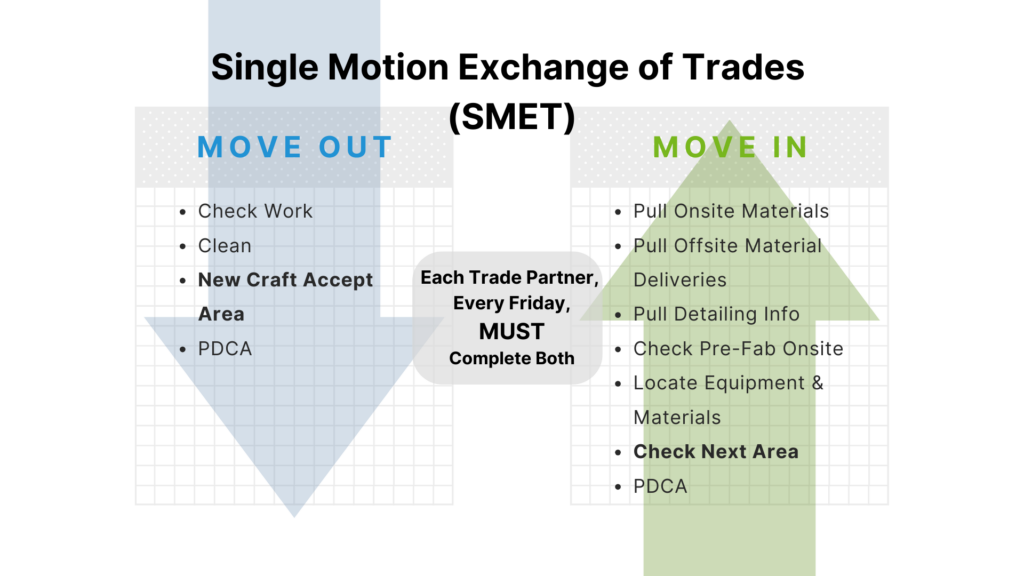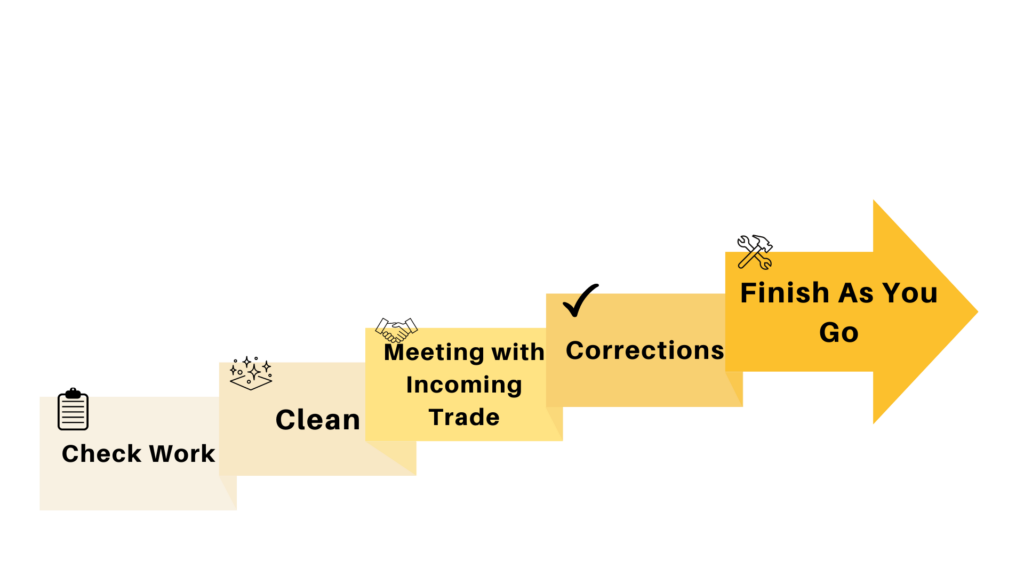For those of you who may not have heard the term Single Motion Exchange of Trade (SMET) before, you’ve probably heard of its predecessor: Shingo’s well-known contribution to production theory Single Motion Exchange of Die (SMED).
So, how do these two differ? In a nutshell, Shingo is striving to solve for efficiency when it comes to the process of changing out metal stamping dies, whereas we (Clear Flow Matrix) are solving for efficiency when it comes to the trade handoffs required to complete the construction schedule successfully. Both have the potential to set any job back exponentially if not done well.
The Skinny on SMET
When it comes to your standard construction project, SMED can be re-aligned to fit our view of production in that the exchange of trades in a work zone is similar to changing a major manufacturing tool such as the one used in Shingo’s example. Take a look at the similarities below:
- SMED: The new die is a different shape, and the old die must be removed.
SMET: The exiting trade is replaced by the new trade.
- SMED: The removed die equipment must be stored elsewhere.
SMET: The exiting trade must relocate to the next zone.
- SMED: The new equipment must be attached to the stamping frame.
SMET: The new equipment and materials must be brought into and arranged in the work zone by the entering trade.
- SMED: Stamping dies are not the same and operations must adjust processing procedures to accommodate the differences.
SMET: The work of the entering trade may not be exactly like their work in the previous work zone so operations in the entered zone must accommodate the differences.
Another Layer of Exchange
If you’re starting to get the similarities between these two production protocols now, good. Mission accomplished! But wait… there’s more.
Shingo has two other categories that he references when it comes to successful production:
- Internal activities are those things that must be accomplished when the equipment is shut down.
- External activities can be accomplished while the machine is operating.
In a similar format, there are certain incoming and outgoing protocols on the construction site that must be completed for a successful handoff:
- In order for the handoff to commence, the trade partner occupying the current work zone must complete any remaining work in the applicable zone before moving to the next. This is referred to as “moving out.”
- Similarly, the trade scheduled to move into that soon-to-be-unoccupied zone has several activities to complete outside the zone before moving in, including negotiating acceptance of the new zone and transporting materials and equipment. We refer to this as “moving in.”

Why It Matters
Without a clear path for successful handoffs, the timelines will become compromised and (as is the case with most jobsites) the Critical Path Method gets introduced in an attempt to secure visibility into the absolute last minute that everything can be done in order to adhere to the schedule dates. And while it may work sometimes, it’s ultimately an unnecessary pressure cooker that actually winds up costing you time and money!
Trades in crashed recovery mode either interfere with other trades via trade stacking or commencing work in additional work zones, ultimately slipping into the same problems the planners sought to alleviate with the modified production plan. When this recovery production schedule fails to remedy the issues, all trades begin to work on the critical path and desire elevated priority status. Beginning in other zones out of sequence or failing to complete zones further disrupting other trades again resulting in the “No Flow Circle”. Ultimately, consuming project and trade managers, and the superintendent in a veritable whirlwind of questions, demands, suggestions all leading to desperate searches for zones to accommodate the trades. Everyone wants to be “off the new critical path” to avoid blame.
What Works Better?
Put simply, smaller handoffs with smaller crews results in a much more manageable and balanced flow. And empowering the trade partners to manage the handoff process from start to finish only serves to increase efficiency through accountability. The most crucial part of the handoff process? It’s shown in the middle below. Meeting with the incoming trades as part of every handoff is by far and away the most foundational step in ensuring the success of any job. And don’t worry – we’ve got you covered here too…

The Clear Flow Matrix app interface is designed and curated specifically to maximize efficiencies with this step. For more information, check it out here!

Recent Comments